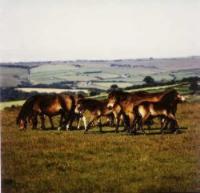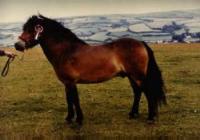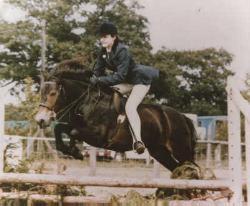|
|
 |
The Exmoor Pony
|
The ponies have been on the Moor
since ancient times, and the Moor shapes their size, their characteristic
hardness, their independent spirit, and that native intelligence which gets
them out of trouble in difficult conditions. Although Exmoors are now being
bred throughout the country, the Moor pony is the foundation stock of this
unique breed from which outside breeders can replenish their stock.
When driving along roads on Exmoor herds or
groups of ponies are frequently to be seen. Not all the ponies on the Moor are
pure bred but there are places such as Withypool, Winsford Hill, Warren Farm,
Molland, Brendon Common and Haddon Hill; here pure bred Exmoor ponies still
find their own living 'in the wild' all the year round. In the Autumn the mares
and foals are 'gathered' and driven down to the farms then the pure-bred
'suckers', as the foals are called, are individually examined by the Society's
Inspectors. If they are accepted into the breed as typical specimens, they are
given an individual number and then branded with that number on the near flank,
together with the Society's star and their herd number on the near shoulder.
That is how you can be sure that the pony shown to you is a true Exmoor, and
how the Society can always tell you his herd, his breeding, and his original
owner. Furthermore it is only from the brand marks that ponies can be
identified as they have no white markings and vary little in colour and height.
A brief
description of an Exmoor:-
Height: Mares not exceeding 12.2 h.h.;
Stallions and Geldings not exceeding 12.3 h.h.
Colours: Bay brown or dun with black points, mealy markings on muzzle
round eyes and inside flanks. No white markings anywhere.
Brief Points: Wide forehead, short thick ears. Toad eye. Legs clean and
short, with strong cannon bone and hard well shaped feet.
|
 |
The Exmoor National Park Authority, great
supporters of the breed, have established two herds on Exmoor in the interests
of conservation and to ensure that the Exmoor Pony remains in its natural
environment for the visitor to enjoy. The National Trust and English Heritage
also have "free living" herds to help to assist in the conservation
of flora and reduction of scrub. Exmoors are very much a rare breed with
numbers of less than 1000 worldwide. Of these there are only around 300
breeding mares producing some 130 foals annually. 150 of the mares are still
"free living" on Exmoor the remainder being in small groups
throughout Britain. Exmoors are "Endangered" on the Rare Breeds
Survival Trust list and of major concern, in addition to the low numbers, are
the few bloodlines remaining and therefore little genetic diversity. Exmoor
Ponies need support, emphasis must be on increasing and preserving the ponies
natural environment and producing a breeding programme to ensure a sound
genetic base for the future of the breed.
Despite their increasing popularity "free
living" Exmoor ponies are wild in the sense that they have to live on the
moor throughout the year, find their own food, care for their young and wander
free over huge areas of moorland surviving a bad winter without additional
shelter or food, although their owners do keep a watchful eye on them. To
maintain breed quality, foals are rigorously inspected prior to registration.
Registered ponies are branded with their herd and pony number and the Society's
star, from this we can always identify its breeder and pedigree. The "free
living" herds remain the essential reservoir of natural characteristics
and it is of utmost importance that the moorland herds continue to enable
breeders, away from the moor, to return to the foundation stock in future
generations. Unlike most other breeds, which have been tailored to human
purpose, the Exmoor's characteristics have evolved naturally. The pony is quite
literally the "child of the moor", the food, climate and living
conditions producing the pony as he is today.
The Royal (Dick) Veterinary College, Edinburgh,
maintains a herd of Exmoors for the benefit of students' studies, the mature
ponies being broken to provide trekking ponies. Exmoors are also bred on
Scoraig, a wild part of North West Scotland, where they are used for postal
delivery, taking the children to school and carrying peat in panniers.
| The Essex Riding
for the Disabled Group have found the Exmoor adaptable and reliable and several
riding schools use them, the pupils competing successfully in pony club events,
gymkhanas, long distance rides and cross country events. A further outlet for
this excellent family pony is driving. The ponies are easy to match for size,
colour and stride, what could be more fitting for a pony which began its useful
life to mankind harnessed to a chariot. One can imagine Boadicea behind a
similar pair leading her tribe to do battle with the Romans. |
 |

The information and pictures on this page are
provided courtesy of the Exmoor Pony Society.
For more information on Exmoor Ponies, please
visit the Exmoor Pony Society website bu clicking the banner above, or contact
the Secretary at the address belowThe British Exmoor Society
Secretary Mr D. Mansell,
Treasurer Mrs S. Mansell. Registered Office: Glen Fern Waddicombe, Dulverton
Somerset, TA22 9RY Telephone & fax 01398 341490
|
The Exmoor Pony also plays a vital role in the
conservation of many other rare species. Click here to find
out more
|

